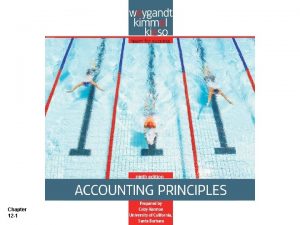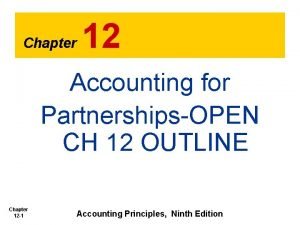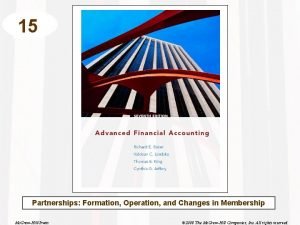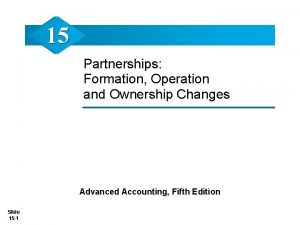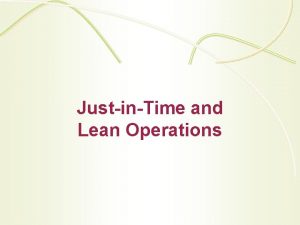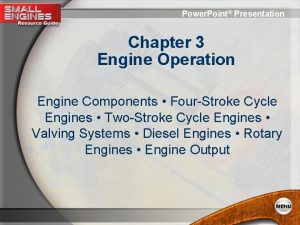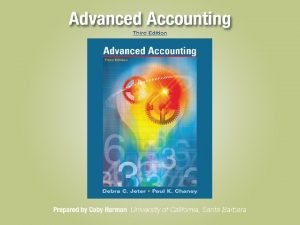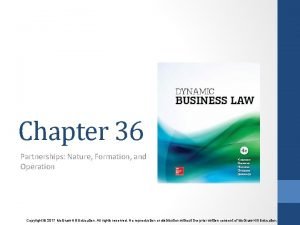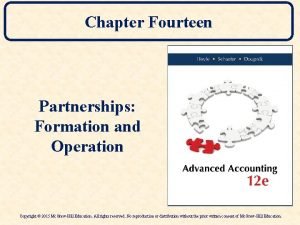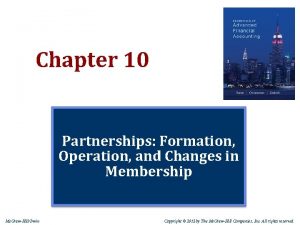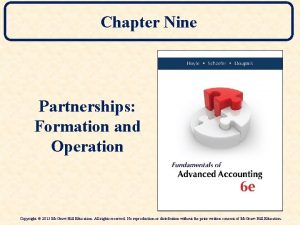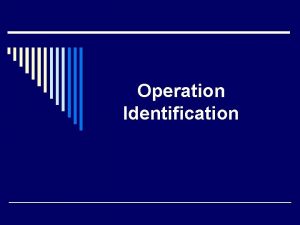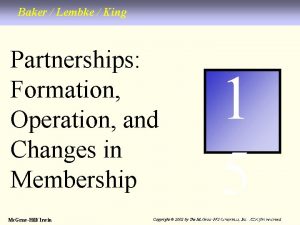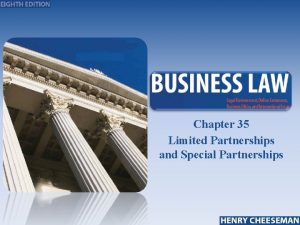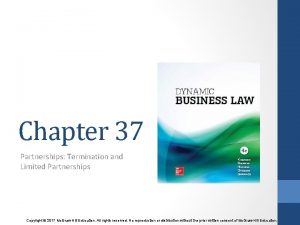CHAPTER 20 PARTNERSHIPS FORMATION AND OPERATION FOCUS OF


























- Slides: 26

CHAPTER 20 PARTNERSHIPS: FORMATION AND OPERATION

FOCUS OF CHAPTER 20 • Types of Partnerships • Major Features of the Partnership Form of Business • Formation of a Partnership • Methods to Share Profits and Losses • Financial Reporting Issues • Income Tax Aspects

Definition of a Partnership • A partnership is an association of two or more persons who: – Are co-owners of a business. – Share profits and losses in an agreedupon manner. • A person can be: – An individual. – A corporation. – Another partnership.

Types of Partnerships • General Partnerships: – All partners have unlimited liability. – Thus creditors can go after the personal assets of any or all of the partners. – Since 1993, many accounting firms have abandoned this form of organization in favor of limited liability partnerships (LLPs).

Types of Partnerships • Limited Liability Partnerships (LLPs): – A partner’s personal assets are at risk only for: • His or her OWN negligence and wrongdoing. • The negligence and wrongdoing of those under his or her control. – This form of organization has not been tested in the courts.

Types of Partnerships • Limited Partnerships: – Certain partners have limited liability to partnership creditors if the partnership is unable to pay its creditors. • Usually the partner’s risk is limited to the partner’s capital invested. • Thus personal assets are not at risk. – At least 1 of the partners must be a general partner.

Partnership Form of Organization: Advantages & Disadvantages • Advantages: – Ease of formation. – Lack of formality. – A closer sense of bonding among partners. – Single taxation (see following slide). • Disadvantages: – Unlimited liability (for general partnerships). – Difficulty of disposing of interest.

Partnership Form of Organization: Income Tax Reporting • Single Taxation of Partnership Earnings: – Partnerships only report their earnings— they are not taxed at the business entity level (as are corporations). • Partnerships file IRS Form 1065, which shows the allocation of profits among partners. • Partners report their share of profits on their individual IRS Form 1040 return.

The Uniform Partnership Act (UPA) • Each state has laws governing the conduct of partnerships. • Most states have adopted the RUPA or a variation thereof. The RUPA covers: – Relations of partners to one another. – Relations of partners to persons dealing with the partnership. – Dissolution and winding up of the partnership.

The Partnership Agreement • The Partnership Agreement: A written expression of what the partners have agreed to. Examples of areas addressed are: – Manner of sharing profits. – Limitations on withdrawals. – Rights of partners. – Settling withdrawing partners. – Expulsion of partners. – Conflicts of interest.

General Matters • SEPARATENESS: The business of a partnership should always be accounted for separately from the partners’ personal transactions. • GAAP: Partnerships—unlike public corporations—do not have to follow GAAP; often they do not. • FOCUS: The accounting focus is achieving equity (fairness) among the partners.

Partners’ Accounts • Each partner can have: – A capital account. – A drawing account (a contra capital account—closed out at year-end). – A loan account (loans usually earn interest—a partnership expense). • Partnerships do NOT use: – A retained earnings account.

Recording the Capital Contributions • Two Fundamental Principles for Achieving Equity among the Partners: – Current values should be used to value: • Noncash assets contributed to a partnership. • Liabilities assumed by a partnership.

Methods to Share Profits and Losses • Partners can share profits and losses in any way they choose. Possible ways include: – Ratios. – Salary allowances and ratios. – Imputed interest on capital, salary allowances, and ratios. – Capital balances only. – Performance methods.

Methods to Share Profits and Losses: Order of Priority Provision • When an “order of priority” provision exists: – The exact sequence for sharing profits and losses specified in the partnership agreement must be followed. – The next lower level method of sharing can be reached if and only if there is still unallocated profit remaining after dealing with the current level.

Review Question #1 Dee and Jay created a partnership (D&J) on 12/31/05 (sharing profits 50 -50). Dee contributed equipment from her sole proprietorship having a carrying value of $5, 000 and a fair value of $9, 000. In 2006, D&J had profits of $88, 000 and borrowed $20, 000 from a bank. In 2006, Dee withdrew $30, 000 cash. Dee’s Y/E capital balance is: A. $13, 000 B. $19, 000 C. $23, 000 D. $43, 000

Review Question #1 With Answer Dee and Jay created a partnership (D&J) on 12/31/05 (sharing profits 50 -50). Dee contributed equipment from her sole proprietorship having a carrying value of $5, 000 and a fair value of $9, 000. In 2006, D&J had profits of $88, 000 and borrowed $20, 000 from a bank. In 2006, Dee withdrew $30, 000 cash. Dee’s Y/E capital balance is: A. $13, 000 B. $19, 000 C. $23, 000 ($9, 000 + $88, 000/2 - $30, 000) D. $43, 000

End of Chapter 20 (Appendix 20 A follows) Time to Clear Things Up—Any Questions?

Appendix 20 A: Income Taxes • A partnership interest is a capital asset —it is the equivalent of owning shares of common stock in a corporation. – Individuals keep track of their cost basis of shares owned in corporations.

Appendix 20 A: Income Taxes • Tax Basis: A partner’s cost basis in the partnership—commonly referred to merely as “basis. ” – Each partner keeps track of his or her own tax basis. – Tracking is needed to determine the taxable gain or loss to be reported on the disposal of the partnership interest.

Appendix 20 A: Income Taxes • Items That Increase Tax Basis: – Profits. – Capital contributions. – An increase in partnership liabilities (shared in the profit and loss sharing ratio). • Items That Decrease Tax Basis: – Losses. – Capital withdrawals (distributions). – A decrease in partnership liabilities.

Appendix 20 A: Income Taxes • What is the most important thing to ignore for tax reporting purposes? ANSWER: A partner’s general ledger capital balance—it is totally irrelevant.

Appendix 20 A Review Question #20 A-1 Dee and Jay created a partnership (D&J) on 12/31/06 (sharing profits 50 -50). Dee contributed equipment from her sole proprietorship having (1) a carrying value of $5, 000, (2) a tax basis of $6, 000, and (3) a fair value of $9, 000. Dee’s tax basis in D&J is: A. $5, 000 B. $6, 000 C. $7, 000 D. $8, 000 E. $9, 000

Appendix 20 A Review Question #20 A-1 With Answer Dee and Jay created a partnership (D&J) on 12/31/06 (sharing profits 50 -50). Dee contributed equipment from her sole proprietorship having (1) a carrying value of $5, 000, (2) a tax basis of $6, 000, and (3) a fair value of $9, 000. Dee’s tax basis in D&J is: A. $5, 000 B. $6, 000 C. $7, 000 D. $8, 000 E. $9, 000

Appendix 20 A Review Question #20 A-2 Use the information in the preceding question, but also assume that (1) Dee contributed a $2, 000 liability to D&J and (2) D&J borrowed $4, 000 from a bank on 12/31/06? What is Dee’s tax basis in D&J? A. $5, 000 B. $6, 000 C. $7, 000 D. $8, 000 E. $9, 000

Appendix 20 A Review Question #20 A-2 With Answer Use the information in the preceding question, but also assume that (1) Dee contributed a $2, 000 liability to D&J and (2) D&J borrowed $4, 000 from a bank on 12/31/06? What is Dee’s tax basis in D&J? A. $5, 000 B. $6, 000 C. $7, 000 ($6, 000 - [$2, 000 x 50%] + [$4, 000 x 50%]) D. $8, 000 E. $9, 000
 Porters generic strategy
Porters generic strategy Business level strategy differentiation
Business level strategy differentiation Accounting for partnerships chapter 12 solutions
Accounting for partnerships chapter 12 solutions Chapter 12 accounting for partnerships answers
Chapter 12 accounting for partnerships answers Prolepsis
Prolepsis Actor focus vs object focus
Actor focus vs object focus Partnership formation and operation
Partnership formation and operation Partnership formation and operation
Partnership formation and operation Partnership formation and operation
Partnership formation and operation Characteristics of limited partnership
Characteristics of limited partnership Accenture development partners
Accenture development partners Word partnership examples
Word partnership examples Product development partnerships
Product development partnerships What is jit
What is jit Maintaining effective partnerships
Maintaining effective partnerships Account www.publicpartnerships.com
Account www.publicpartnerships.com Epsrc prosperity partnerships
Epsrc prosperity partnerships Formation initiale vs formation continue
Formation initiale vs formation continue Linux operation and administration chapter 8
Linux operation and administration chapter 8 Operations and productivity chapter 1
Operations and productivity chapter 1 Chapter 3 shielded metal arc equipment setup and operation
Chapter 3 shielded metal arc equipment setup and operation Art in focus
Art in focus Chapter 10 weathering and soil formation answers
Chapter 10 weathering and soil formation answers Engine operation chapter 3 test 1 answer key
Engine operation chapter 3 test 1 answer key Operation management chapter 3
Operation management chapter 3 Global operations strategy options
Global operations strategy options Chapter 5 principles of engine operation
Chapter 5 principles of engine operation


